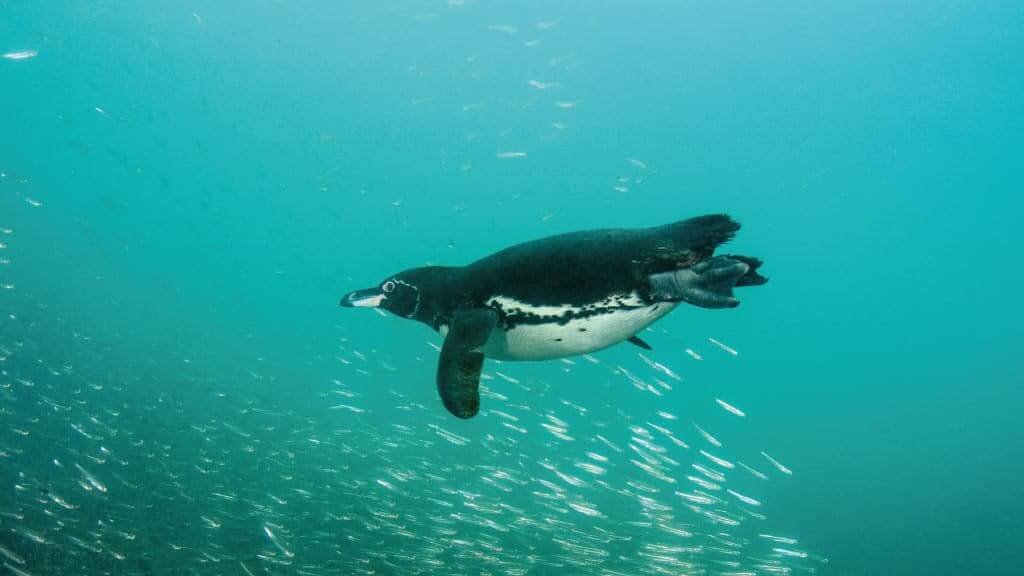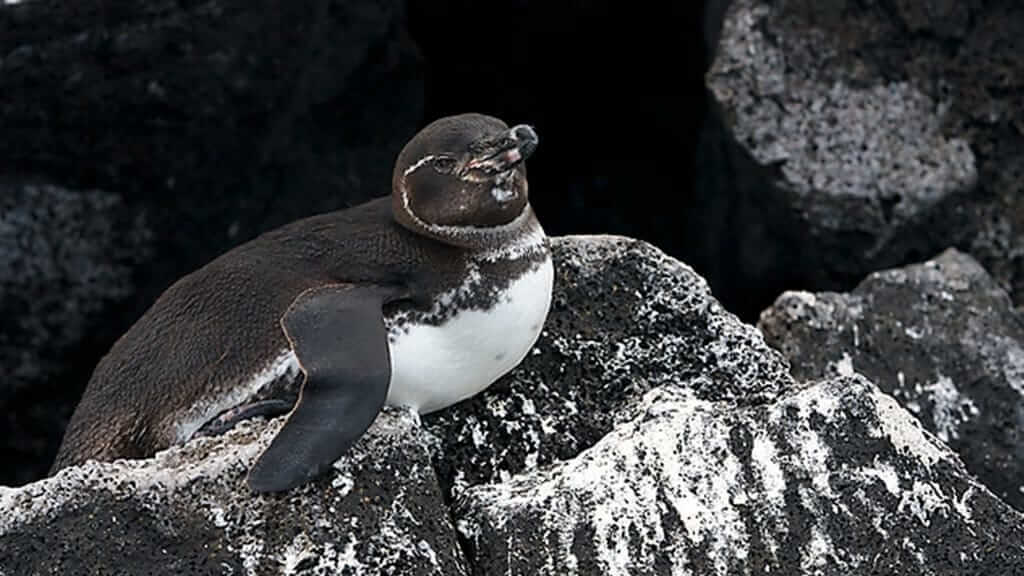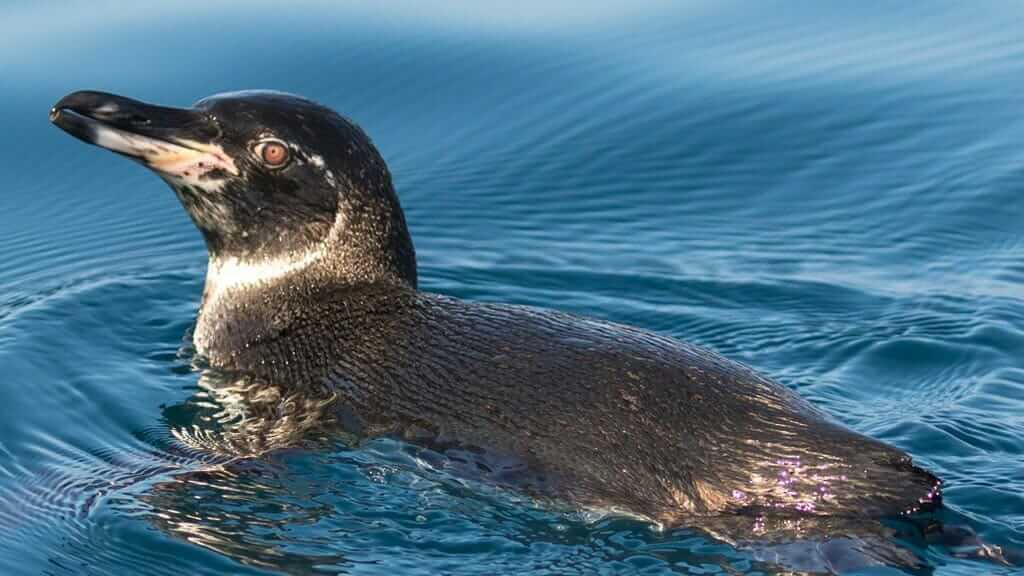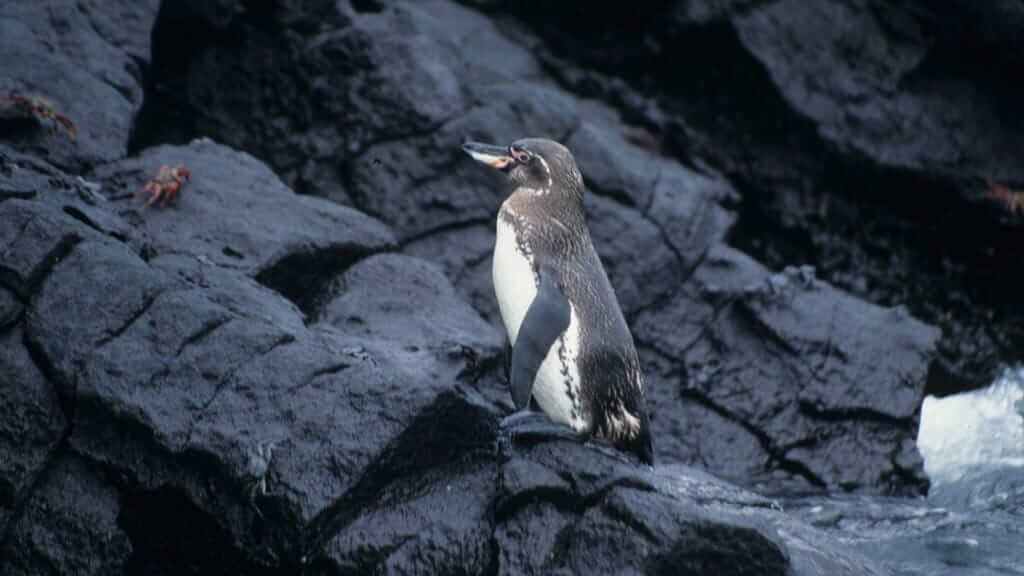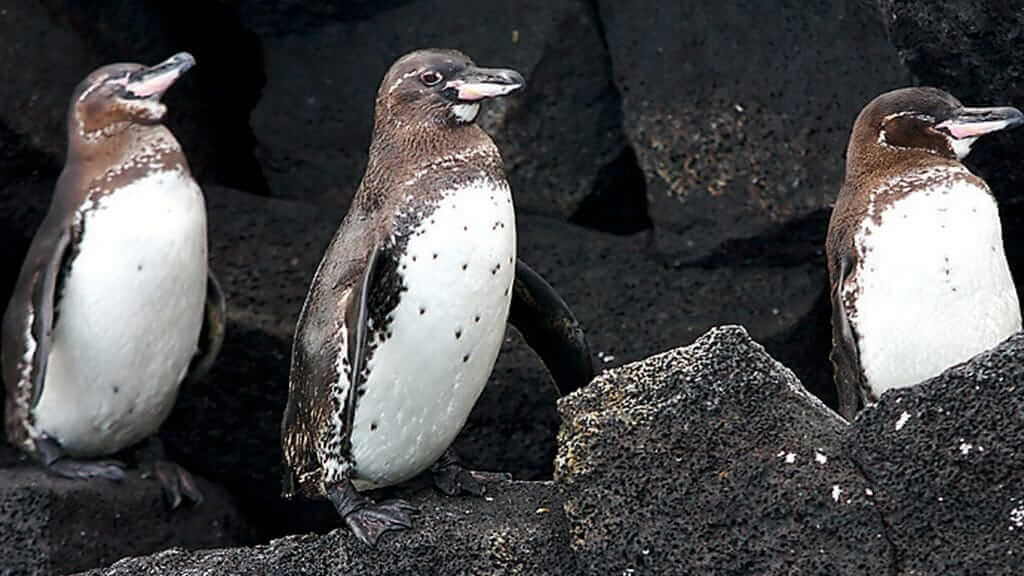GALAPAGOS PENGUIN
Let’s face it, everyone loves a cute penguin! From Happy Feet to Skipper, Kowalski, Rico & Private, adventurous penguins have hit the big screen. In the real world, what greater adventure than the penguin who moved to the Galapagos to live on the equator? The Galapagos penguin is one of the smallest in the world, and the only one of its species found in the heat of the tropics. Visitors can even swim or snorkel with Galapagos penguins, now that's a unique tick for anyone's bucket list!
The Galapagos penguin is endemic to the archipelago, meaning that they can only be found here. So, pack your snorkel gear and camera, and come meet the Galapagos Penguin for yourself. This is one of the more unusual wildlife stories on the planet.
Keep reading to discover the incredible story of the Galapagos Penguin. How and why did penguins journey to the equator, and decide to live there? Where and when can visitors see Galapagos Penguins on a cruise or tour? Plus heaps of other fun Galapagos Penguin facts.
SECURE YOUR GALAPAGOS TRAVEL
Get a FREE personalised quote todayThe Galapagos Penguin is an ENDEMIC SPECIES.
Conservation Status: Endangered.
Galapagos Penguin Scientific Name: Spheniscus mendiculus.
How to See a Galapagos Penguin?
The Galapagos Penguin population size is small with just 2000 individual birds. Although they don't inhabit all islands in the Galapagos, the good news is that they nest and hunt at very specific and predictable Galapagos visitor sites.
The easiest way to see a Galapagos Penguin in person is as part of a cruise itinerary, or with careful planning and a little luck on a Galapagos land tour.
WHERE does the Galapagos Penguin live?
The largest Galapagos Penguin colonies are found on the western side of Isabela Island, and at Punta Espinosa on Fernandina Island. Sightings in these areas are very common, but not all Galapagos Cruise itineraries head to the west of the archipelago so be sure to check your trip itinerary carefully during trip planning.
A small colony can also be spotted at Bartolome Island. Snorkelers often find them in the waters around Pinnacle Rock or close to Santiago Island. Sometimes they hunt for fish around Chinese Hat and Rabida too. Bartolome is a common inclusion on cruise itineraries, and can also be visited as a day tour from Santa Cruz.
So, visitors have quite a few options of where to see Galapagos Penguins. To maximize your chances we recommend a cruise to Fernandina and the western side of Isabela. Here, the Galapagos Penguin populations are larger, and present all year round.
Occasionally, a few Galapagos Penguins also hang out close to Puerto Villamil Harbor to the southeast of Isabela Island. Keep your eyes peeled as you disembark the inter-island ferry. If lucky you might spot penguins zipping around in the clear waters under the boardwalk. They also like to sit out on the black volcanic rocks close to the Las Tintoreras visitor site in the bay.
A very small colony of Galapagos Penguins can also occasionally be spotted at Post Office Bay on Floreana Island, but this is less common.
WHEN is the Best Time to see Galapagos Penguins?
The good news is that Galapagos Penguins can be spotted in the archipelago all year round.
The Galapagos Penguin nesting season typically lasts from May to December, that is, the Galapagos cool and dry season. During these months the Humboldt Current arrives from Antarctica. This is a cold water current, bringing rich nutrients to Galapagos waters. So, the Galapagos Penguin takes advantage of the abundant food to reproduce and rear their offspring. In general, this is the best time of year for all Galapagos marine species.
Contact us for a FREE GALAPAGOS TOUR QUOTE, or for more information about how to plan your vacation at the Galapagos Islands to snorkel with Galapagos Penguins.
Everything You Ever Wanted To Know About The Galapagos Penguin
Galapagos Penguin Size
The Galapagos Penguin is the second smallest penguin species on the planet (the smallest species is the Little Penguin found in New Zealand). Galapagos Penguins grow up to 20 inches (50 cm) in height, weighing in at a mere 5.5 pounds on average (up to 8.8 pounds max). For comparison an adult Emperor Penguin weighs a full 18 times more!
Why are Galapagos Penguins so small? Living within the tropics they no longer need much body fat in order to stay warm, so they adapted to local conditions and slimmed down.
Galapagos Penguin Lifespan
At the Galapagos islands, penguins have an average lifespan of between 15 & 20 years.
Galapagos Penguin Appearance
It's really easy to identify a Galapagos Penguin. For starters, they are the only penguin species found in the Galapagos. In appearance, their bodies are black on the back, with a white underbelly. Their heads are also black, with a white circular border. Their beaks are light pink underneath. Galapagos Penguins also have a white eye ring surrounding their black eyes.
Galapagos Penguin Adaptations
So, how exactly did a cold-water penguin end up living at the equator?
The Galapagos Penguin is originally related to the Humboldt Penguin from the cold waters of Chile in South America. It is generally accepted that penguins first arrived at Galapagos shores some 4 million years ago, swimming north on ocean currents. Marine food sources at the Galapagos islands are abundant and plentiful, so they decided to stay.
But to survive in the tropics, not surprisingly, the Galapagos Penguin had to make several adaptations.
The most obvious adaptation is in physical size. The Galapagos Penguin lost excess body fat that was no longer required to keep them warm in the cold Antarctic. Today Galapagos Penguins are perfectly lean and streamlined for warm weather conditions.
But even that is not enough to keep a Galapagos penguin cool on a hot day. The most important Galapagos Penguin adaptation is their method of thermo-regulation. Penguins have no sweat glands, so when they become too hot they have to adapt their behavior. The Galapagos Penguin spends much of the day immersed in the cool water, or under shady rock overhangs. The Galapagos Penguin has also learned how to pant like a dog in order to keep cool.
Galapagos Penguin Behavior
Galapagos Penguin reproduction and nesting usually take place between May and December. Galapagos Penguins intelligently adapt to their environment, only breeding when natural circumstances allow. They lay one or two eggs per clutch. Both male and female Galapagos penguins share the work of incubation for 35-40 days to keep eggs cool. After hatching both parents similarly share the toil of rearing chicks and hunting food for them. Fluffy little dark-colored Galapagos Penguin chicks typically fledge after eight to nine weeks.
Similar to other penguin species, The Galapagos Penguin is a flightless bird. They are rather clumsy on land, but it's a completely different story in the water. Galapagos penguins swim like streamlined bullets, capable of reaching speeds of up to 35km/h. They are also extremely agile swimmers, making sharp direction changes look deceptively easy.
GET FREE ADVICE
From a Galapagos destination expert todayGalapagos Penguin Diet
What do Galapagos Penguins eat? Their diet consists mostly of cold water fish such as anchovies, sardines, and mullet. On occasion they may also eat mollusks. Hunting is a daytime activity, and usually takes place close to Galapagos Penguin nesting sites.
Galapagos Penguin Habitat
Galapagos Penguins need shade, especially for nesting. They love lava rocks with caves or crevices which provide perfect shelter. Not surprisingly they hang out close to shore with easy access to the sea. At the Galapagos, they nest close to areas with the coldest water currents (and richest food sources), generally to the west of the archipelago
Why is the Galapagos Penguin Endangered?
The Galapagos Penguin is the rarest and most endangered penguin species in the world, listed on the IUCN Red List as "Endangered" with a "decreasing" population trend.
Galapagos Penguin predators include Galapagos hawks, short-eared owls, Racer snakes, and sharks. But it's not only natural predators that they need to look out for. Invasive species introduced by humans also pose a threat, principally cats, dogs, and rats.
Another big threat to the Galapagos Penguin is the El Niño weather phenomenon. El Niño occurs every decade or so, affecting the whole coast of South America. It causes a small rise in sea temperatures, which in turn reduces the important nutrients found in the ocean. Fewer algae, plankton, and nutrients mean fewer fish, which also means hungry penguins. The last major El Niño event occurred back in 1982 and wiped out around 77% of the Galapagos Penguin population. Not only were adult penguins starving to death, but they were also unable to breed that year. It took many years for the Galapagos Penguin population to recover.
Galapagos Penguin Conservation
What is being done to help conserve the Galapagos Penguin population?
An active Galapagos Penguin conservation project is being led by the Galapagos Conservancy. One of the reasons for their endangered status is the lack of suitable nesting sites. Many old Galapagos Penguin nests either no longer exist or are now occupied by Marine Iguanas. So, in 2010, Dr. Dee Boersma of the University of Washington and her team built 120 high-quality, artificial Galapagos Penguin nest sites for them to use. Monitoring trips since then indicate that penguins have been putting the nests to good use. The % of juvenile Galapagos Penguins observed in the colony has increased from 45 to 60%.
In September 2020 a research group from the Charles Darwin Foundation reported record numbers of Galapagos Penguins nesting at Isabela and Fernandina islands. The recent La Niña event (kind of a reverse El Niño) was believed to have helped, as temporarily cold ocean currents brought more food for marine species. Perhaps the pause in tourist numbers during the Covid Pandemic was also beneficial.
Facts About The Galapagos Penguin
• They are the only global penguin species with no fixed breeding season. The Galapagos Penguin is able to choose whether or not to mate each season. So, in years of food abundance, they will mate, giving their chicks the best possible chance of survival. Usually, Galapagos Penguin mating occurs during the cool & dry Galapagos weather season from May to December, but it can vary. Galapagos penguins are capable of laying eggs up to three times in a good year, or in times of food scarcity, they may not breed that year at all.
• Galapagos Penguins are the only species in the world at serious risk of sunburn. In particular, their delicate feet are prone to burning. It's for this reason that they walk in a slightly hunched way, leaning forward to keep their feet in the shade.
• Galapagos Penguins are rather romantic creatures & loyal lovers, mating for life with a single partner. Penguin couples can often be observed preening one another and tapping bills to strengthen their bond and communicate emotions.
• While most penguin species molt just once each year, the Galapagos Penguin will shed his/her feathers 2 or 3 times over the same period. The strong tropical sun takes its toll on feathers, so more frequent molting is required to keep feathers in pristine condition. They’ll usually molt before breeding and are unable to go into the water until a new coat grows.
• Galapagos Penguins swim like torpedos, capable of reaching impressive speeds of up to 35km/h. Compare that to the much slower 7.6km/h of Olympic gold medalist Michael Phelps. If you are lucky enough to snorkel with a Galapagos penguin you’ll appreciate just how fast and agile they are in the water, making sharp direction changes look easy.
Check out our other blog post for even more fun facts about Galapagos Penguins. If you enjoyed this post, then we think you’ll also like our Galapagos Birds and Galapagos Animals blogs.
Book with The #1 Trusted
Galapagos Travel Agency
In conclusion, the Galapagos Penguin is one of the very top Galapagos wildlife highlights. Everyone loves a penguin, but most visitors are left astonished to find them living so happily on the equator. Observing and photographing Galapagos Penguins on land is a wonderful experience. But swimming with them in the sea raises it to a whole new level. Snorkeling with Galapagos Penguins is highly recommended, and for many makes their top vacation memory. Get in touch with us, we'd love to help you to make it happen!



